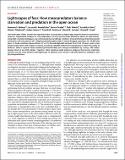Files in this item
Lightscapes of fear : how mesopredators balance starvation and predation in the open ocean
Item metadata
| dc.contributor.author | Beltran, Roxanne S. | |
| dc.contributor.author | Kendall-Bar, Jessica M. | |
| dc.contributor.author | Pirotta, Enrico | |
| dc.contributor.author | Adachi, Taiki | |
| dc.contributor.author | Naito, Yasuhiko | |
| dc.contributor.author | Takahashi, Akinori | |
| dc.contributor.author | Cremers, Jolien | |
| dc.contributor.author | Robinson, Patrick W. | |
| dc.contributor.author | Crocker, Daniel E. | |
| dc.contributor.author | Costa, Daniel P. | |
| dc.date.accessioned | 2021-03-26T15:30:10Z | |
| dc.date.available | 2021-03-26T15:30:10Z | |
| dc.date.issued | 2021-03-17 | |
| dc.identifier | 273499420 | |
| dc.identifier | a1090dc5-2692-44d4-a791-e77958137c32 | |
| dc.identifier | 85102658523 | |
| dc.identifier | 000633443000012 | |
| dc.identifier.citation | Beltran , R S , Kendall-Bar , J M , Pirotta , E , Adachi , T , Naito , Y , Takahashi , A , Cremers , J , Robinson , P W , Crocker , D E & Costa , D P 2021 , ' Lightscapes of fear : how mesopredators balance starvation and predation in the open ocean ' , Science Advances , vol. 7 , no. 12 , eabd9818 . https://doi.org/10.1126/sciadv.abd9818 | en |
| dc.identifier.issn | 2375-2548 | |
| dc.identifier.other | Jisc: a3dd62fcd05c4401a4198e7bacdbcfe8 | |
| dc.identifier.uri | https://hdl.handle.net/10023/21726 | |
| dc.description | Funding: Financial support for this research was provided by an NSF Postdoctoral Research Fellowship in Biology and UC Santa Cruz Chancellor’s Postdoctoral Fellowship (R.S.B.), as well as the Office of Naval Research, the E&P Sound and Marine Life Joint Industry Project of the International Association of Oil and Gas Producers (D.P.C.), and the Novo Nordisk Foundation (“Harnessing The Power of Big Data to Address the Societal Challenge of Aging”, NNF17OC0027812) (J.C.). | en |
| dc.description.abstract | Like landscapes of fear, animals are hypothesized to strategically use lightscapes based on intrinsic motivations. However, longitudinal evidence of state-dependent risk aversion has been difficult to obtain in wild animals. Using high-resolution biologgers, we continuously measured body condition, time partitioning, three-dimensional movement, and risk exposure of 71 elephant seals throughout their 7-month foraging migrations (N = 16,000 seal days). As body condition improved from 21 to 32% fat and daylength declined from 16 to 10 hours, seals rested progressively earlier with respect to sunrise, sacrificing valuable nocturnal foraging hours to rest in the safety of darkness. Seals in superior body condition prioritized safety over energy conservation by resting >100 meters deeper where it was 300× darker. Together, these results provide empirical evidence that marine mammals actively use the three-dimensional lightscape to optimize risk-reward trade-offs based on ecological and physiological factors. | |
| dc.format.extent | 9 | |
| dc.format.extent | 1911095 | |
| dc.language.iso | eng | |
| dc.relation.ispartof | Science Advances | en |
| dc.subject | GC Oceanography | en |
| dc.subject | QH301 Biology | en |
| dc.subject | DAS | en |
| dc.subject | SDG 7 - Affordable and Clean Energy | en |
| dc.subject | SDG 14 - Life Below Water | en |
| dc.subject.lcc | GC | en |
| dc.subject.lcc | QH301 | en |
| dc.title | Lightscapes of fear : how mesopredators balance starvation and predation in the open ocean | en |
| dc.type | Journal article | en |
| dc.contributor.institution | University of St Andrews. School of Biology | en |
| dc.identifier.doi | https://doi.org/10.1126/sciadv.abd9818 | |
| dc.description.status | Peer reviewed | en |
This item appears in the following Collection(s)
Items in the St Andrews Research Repository are protected by copyright, with all rights reserved, unless otherwise indicated.

